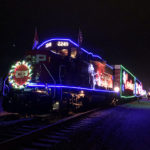Home »

Northern lights dancing in East Kootenay skies
The Space Weather Prediction Center (SWPC) with the U.S. National Oceanic and Atmospheric Administration (NOAA) has issued a G3 (Strong) Geomagnetic Storm Watch for October 30/31, following a significant solar flare and Coronal Mass Ejection (CME) from the sun that occurred around 11:35 a.m. EDT on Oct. 28.
“Analysis indicated the CME departed the Sun at a speed of 973 km/s and is forecast to arrive at Earth on October 30, with effects likely continuing into October 31. When the CME approaches Earth, NOAA’s DSCOVR satellite will be among the first spacecraft to detect the real time solar wind changes and SWPC forecasters will issue any appropriate warnings,” SWPC stated.
“Impacts to our technology from a G3 storm are generally nominal. However, a G3 storm has the potential to drive the aurora further away from its normal polar residence and if other factors come together, the aurora might be seen over the far northeast, to the upper midwest, and over the state of Washington.”
So be prepared for a major sky show tonight and tomorrow, with clear sky conditions forecast. And you might want to consider shutting off electronic devices to be on the safe side the next 24 hours.
Rick Nowell, Physics Lab Tech at College of the Rockies, was busy earlier this month capturing the beautiful, ethereal sky dance of the Northern Lights that were on full, glorious display.
“The Northern Lights were visible over the East Kootenay on Monday, October 11 and early Oct. 12. This was due to a M 1.6 class solar flare on Oct. 9 that sent a coronal mass ejection that hit Earth on Oct. 12, triggering a G2 solar storm. They were bright enough to be seen in Vancouver, Calgary and Edmonton. Americans reported seeing it as far South as Iowa, Minnesota and Ohio,” Nowell said.

“Hints of the aurora started around 10 p.m. and it slowly built up as a glowing gray band along the northern horizon. The NOAA space weather site showed a solar storm warning with a strong Kp=6 on the index scale. [The Kp index levels range from a quiet 0 to an intense 9.] It was worth driving out to a dark area near Wasa to check it out. By midnight it showed as two bright horizontal bands to the north horizon (as in the photo above) steadily brightening into a greenish glow and climbing above the Big Dipper stars.
“At 12:20, it suddenly broke up into bright green checkerboard patches and discharged as moving glowing spikes and curves to the northeast over Mt Bill Nye. Visibly you could see the pale green moving “flames” with reddish tints at their base. These rotated as two long cylindrical curtains: an inner brighter one rotated right, while a larger cylinder rotated left outside of it,” Nowell related.
Above video: Moving green flames over Mt Bill Nye to the Northeast with crimson at the base. This is an animated GIF with 12 frames from a small video AuroraNik_720x480 (attached).
The bright discharge subsided to a dim green glow after ten minutes, but four hours later reappeared as bright spikes (at 04:43 am MDT) as shown here in an animated GIF using frames from the college Meteor Cam.
“The aurora was bright and moving fast enough for video. The video above shows one minute of the green flames moving over Mt. Bill Nye. Video can be grainy and dim for low-light displays like this. Normally you would set the camera on a tripod and take time-exposures of around two to six seconds at 3200 ISO for each photo. Except the aurora curtains were moving too swiftly for that. The problem is, HD-1080 video is taken at 24 frames/second, so your exposure time is too brief, just 0.04sec per frame. But here I’m using a fast f/1.8 wide-angle 28mm lens which gathers a lot of light, and using 6400 ISO on the camera, which helps brighten it. It is still grainy and dim, my eye saw it brighter than the movie,” Nowell explained.
“The Northern Lights haven’t been very active the past few years. This was the first widespread occurrence. The sun has an 11-year cycle of quiet and noisy periods. We just passed the “minimum” from 2019 to April 2020. We should see more occurrences now, with max activity predicted for July 2025. For more info.
Nowell provided e-KNOW with more details about recent solar flare activity.
THE CAUSE: Solar flares that send ionized hydrogen blowing out from the Sun’s corona, containing protons and electrons. After a few days this hits the Earth and is funnelled into the Earth’s magnetic field lines at the North and South poles. It corkscrews down, and where the magnetic field lines get close together, bounces back from just above the atmosphere, around 57-63 degrees north latitude. Then it corkscrews back up again and bounces back and forth. More charge accumulates and pushes the magnetic field lines further and further apart, (it also creates a huge “ring current” circling the Earth which distorts the Earth’s magnetic field) and the charges speed up and come lower down, until the electrons and protons finally spray out along curving lines, and escape into the ionosphere at about 80 to 200 km high to collide with oxygen and nitrogen in the air.
COLOURS SEEN: The green and red glow from aurorae are jumps of electrons in oxygen atoms high in the atmosphere. The bright green that is most often seen, occurs from oxygen between 80 to 100km high. These are quick transitions, lasting 1/3 of a second, and bright. The dim red above the green auroral curtains (above 200 km) is also produced by oxygen atoms jumping from the excited state left over from the transition above and ending up in the “ground-state,” oxygen’s normal resting place. This transition is a slow event, taking around 104 seconds to complete and dim to see.
Lead image: During a strong aurora, nitrogen gas is hit hard enough by electrons to glow blue between the red and green layers and to glow crimson along the bottom edges of the curtains at 80 km. Here is an example showing the blues from May 2016. Facing north from Fernie, the constellation Cassiopeia above. Sasha Prystae (of Kimberley) photo
e-KNOW








